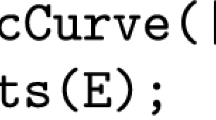Abstract
We examine the ternary codes \(C_3(A_i+I)\) from matrices \(A_i+I\) where \(A_i\) is an adjacency matrix of a uniform subset graph \(\Gamma (n,3,i)\) of \(3\)-subsets of a set of size \(n\) with adjacency defined by subsets meeting in \(i\) elements of \(\Omega \), where \(0 \le i \le 2\). Most of the main parameters are obtained; the hulls, the duals, and other subcodes of the \(C_3(A_i+I)\) are also examined.
Similar content being viewed by others
Explore related subjects
Discover the latest articles, news and stories from top researchers in related subjects.References
Assmus, E.F. Jr, Key, J.D.: Designs and Their Codes. Cambridge Tracts in Mathematics, vol. 103. Cambridge University Press, Cambridge (1992). (Second printing with corrections, 1993)
Bosma, W., Cannon, J., Playoust, C.: The Magma algebra system I: the user language. J. Symb. Comput. 24(3/4), 235–265 (1997)
Cannon, J., Steel, A., White, G.: Linear codes over finite fields. In: Cannon, J., Bosma, W. (eds.) Handbook of Magma Functions, Computational Algebra Group, Department of Mathematics, University of Sydney, vol. 2.13, pp. 3951–4023 (2006) http://magma.maths.usyd.edu.au/magma
Dankelmann, P., Key, J.D., Rodrigues, B.G.: A characterization of graphs by codes from their incidence matrices. Electron. J. Comb. 20(3), P18 (2013)
Dankelmann, P., Key, J.D., Rodrigues, B.G.: Codes from incidence matrices of graphs. Des. Codes Cryptogr. 68, 373–393 (2013)
Fish, W., Key, J. D., Mwambene, E.: Binary codes from reflexive graphs on \(3\)-sets (Submitted)
Fish, W., Key, J.D., Mwambene, E.: Binary codes from designs from the reflexive \(n\)-cube. Util. Math. 85, 235–246 (2011)
Fish, W.: Codes from uniform subset graphs and cycle products. Ph.D. thesis, University of the Western Cape (2007)
Ghinelli, D., Key, J.D., McDonough, T.P.: Hulls of codes from incidence matrices of connected regular graphs. Des. Codes Cryptogr. 70, 35–54 (2014). doi:10.1007/s10623-012-9635-0
Haemers, W.H., Peeters, R., van Rijckevorsel, J.M.: Binary codes of strongly regular graphs. Des. Codes Cryptogr. 17, 187–209 (1999)
Huffman, W.C.: Codes and groups. In: Pless, V.S., Huffman, W.C. (eds.) Handbook of Coding Theory, Part 2, Chap. 17, vol. 2, pp. 1345–1440. Elsevier, Amsterdam (1998)
Key, J.D., Moori, J., Rodrigues, B.G.: Binary codes from graphs on triples. Discret. Math. 282(1–3), 171–182 (2004)
Key, J.D., Moori, J., Rodrigues, B.G.: Partial permutation decoding of some binary codes from graphs on triples. Ars Comb. 79, 11–19 (2006)
Key, J.D., Moori, J., Rodrigues, B.G.: Ternary codes from graphs on triples. Discret. Math. 309, 4663–4681 (2009)
Author information
Authors and Affiliations
Corresponding author
Appendix
Appendix
The general description of the words \(w_\pi \) that sum to give \(w_1-w_2\) when \(n \equiv 0 \text{(mod } 3\text{) }\) used in the proof of Proposition 6 is given here. For short, we write \([i,j,k,l]\) to denote the word \(w_\pi \) from the partition \([[1,2],[i,j],[k,l]]\) as defined in Definition 2. We take the sum of:
It is easy to verify that these \(\frac{1}{3}(n-3)(n-4)\) words \(w_\pi \) add up to \(w_1-w_2\).
Rights and permissions
About this article
Cite this article
Fish, W., Key, J.D. & Mwambene, E. Ternary codes from some reflexive uniform subset graphs. AAECC 25, 363–382 (2014). https://doi.org/10.1007/s00200-014-0233-4
Received:
Revised:
Accepted:
Published:
Issue Date:
DOI: https://doi.org/10.1007/s00200-014-0233-4



